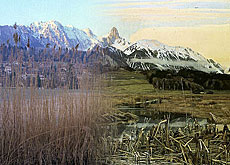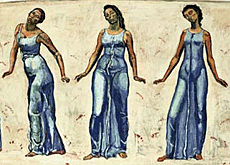Hodler’s landscapes receive a contemporary touch

The work of renowned Swiss artist Ferdinand Hodler is in the spotlight this year, the 150th anniversary of his birth.
To mark the occasion, swissinfo sent photographer Christian Helmle to follow in the artist’s footsteps, capturing on film the Swiss locations Hodler depicted on canvas.
Born in a poor quarter of canton Bern on March 14, 1853, Hodler’s fortunes improved markedly and he died a wealthy man on May 19, 1918.
Between these two dates, Hodler became one of the most celebrated Swiss artists, producing an impressive body of work.
The “national” artist was frequently commissioned to paint patriotic-historical works, which no longer appeal to current tastes.
But he was also, and perhaps above all, a painter of landscapes.
Time and space
This side of the artist’s work is the subject of an exhibition, “Ferdinand Hodler, The Landscape”, which runs at the Rath Museum in Geneva until February 1. The exhibition will then travel to the Kunsthaus in Zurich where it will stay until June 6.
In its own tribute to the landscape painter, swissinfo sent Bernese photographer Christian Helmle to visit the areas captured by Hodler, and bring them to life once more through his photography.
Hodler lived in Geneva from the age of 18, but returned frequently to canton Bern to paint Lake Thun and the Bernese Oberland.
Helmle faced several problems as he set about fulfilling his assignment. Firstly the time of year and day, since the light at dawn on a summer day is not the same as that at sunset in autumn.
Another hurdle to be overcome was location, as a lot of research had to be done to find the exact scene painted by Hodler. Fortunately, Helmle knows the Oberland well and he was also helped by the fact that Hodler – who was fairly stout – always painted scenes easy to reach by public transport.
Distorted reality?
Photographs can no longer be taken at face value. Computer technology allows photographers to transform their images.
But in this case, it was more Hodler who sought to interpret reality than Helmle.
“He worked with great precision, drawing his landscape onto a piece of glass. But, his mountains, for example, are always a bit more pointed than in reality,” commented Helmle.
Hodler’s practice was to make several sketches in the open, but then produce the painting in his studio. He would combine elements from the different sketches to create one picture.
As for clouds: “He uses them like an ornament, almost like a frame,” Helmle said.
In visiting the locations favoured by Hodler, Helmle also traced the evolution of the painter, through a study of his style and his approach.
He saw how Hodler moved from a rather simple romanticism in his early works to a far more personal style: “He became more abstract, more dramatic in a way. He was liberated in fact,” Helmle said.
A century later
The locations depicted by Hodler have undergone many changes since his day.
“There are many more electricity cables and homes,” Helmle told swissinfo. “But what struck me the most was that we have more trees now.”
Although good news for the environment, this reforestation had one down side as far as Helmle was concerned. The photographer was unable to capture one of the scenes painted by Hodler as since the artist’s day a forest has grown up, obscuring the view.
Helmle said he had learned from the painter to think more in terms of centring, and to recognise the differences between their respective methods of capturing – and personalising – reality.
“The photographer looks for the remarkable. Hodler chose more classic locations, which he then rendered spectacular and dramatic in his studio. He was much more free than a photographer,” Helmle said.
swissinfo, Bernard Léchot (translation: Samantha Tonkin)
swissinfo is commemorating the 150th anniversary of the birth of Swiss landscape artist, Ferdinand Hodler.
The Rath Museum in Geneva has a dedicated exhibition celebrating his landscape paintings which will travel to the Kunsthaus in Zurich from March 2004.
swissinfo asked Swiss photographer, Christian Helmle, to retrace the artist’s steps.

In compliance with the JTI standards
More: SWI swissinfo.ch certified by the Journalism Trust Initiative

You can find an overview of ongoing debates with our journalists here. Please join us!
If you want to start a conversation about a topic raised in this article or want to report factual errors, email us at english@swissinfo.ch.